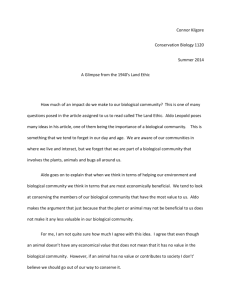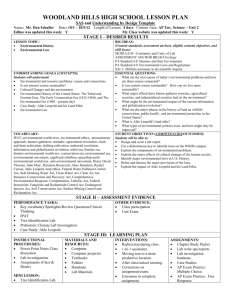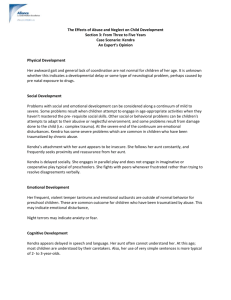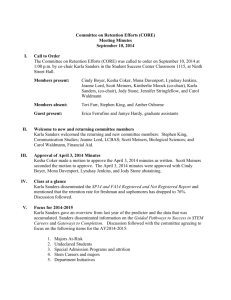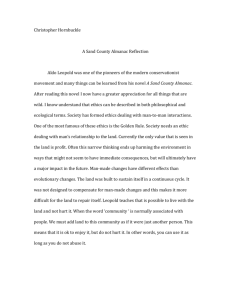File - Bailiwick Press
advertisement
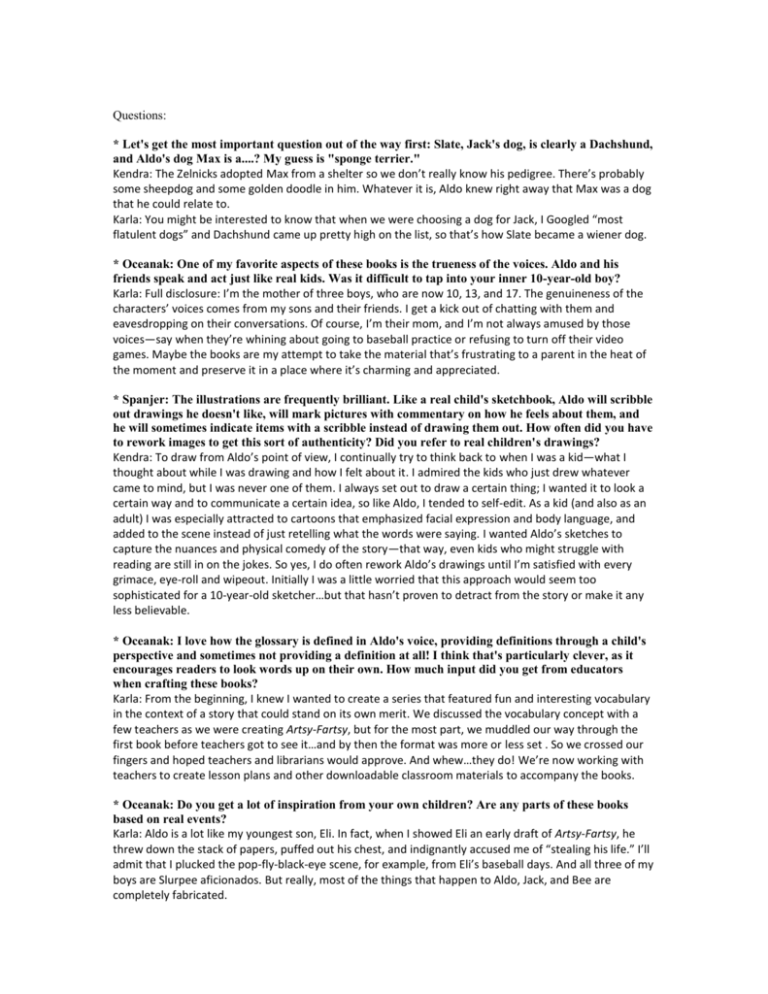
Questions: * Let's get the most important question out of the way first: Slate, Jack's dog, is clearly a Dachshund, and Aldo's dog Max is a....? My guess is "sponge terrier." Kendra: The Zelnicks adopted Max from a shelter so we don’t really know his pedigree. There’s probably some sheepdog and some golden doodle in him. Whatever it is, Aldo knew right away that Max was a dog that he could relate to. Karla: You might be interested to know that when we were choosing a dog for Jack, I Googled “most flatulent dogs” and Dachshund came up pretty high on the list, so that’s how Slate became a wiener dog. * Oceanak: One of my favorite aspects of these books is the trueness of the voices. Aldo and his friends speak and act just like real kids. Was it difficult to tap into your inner 10-year-old boy? Karla: Full disclosure: I’m the mother of three boys, who are now 10, 13, and 17. The genuineness of the characters’ voices comes from my sons and their friends. I get a kick out of chatting with them and eavesdropping on their conversations. Of course, I’m their mom, and I’m not always amused by those voices—say when they’re whining about going to baseball practice or refusing to turn off their video games. Maybe the books are my attempt to take the material that’s frustrating to a parent in the heat of the moment and preserve it in a place where it’s charming and appreciated. * Spanjer: The illustrations are frequently brilliant. Like a real child's sketchbook, Aldo will scribble out drawings he doesn't like, will mark pictures with commentary on how he feels about them, and he will sometimes indicate items with a scribble instead of drawing them out. How often did you have to rework images to get this sort of authenticity? Did you refer to real children's drawings? Kendra: To draw from Aldo’s point of view, I continually try to think back to when I was a kid—what I thought about while I was drawing and how I felt about it. I admired the kids who just drew whatever came to mind, but I was never one of them. I always set out to draw a certain thing; I wanted it to look a certain way and to communicate a certain idea, so like Aldo, I tended to self-edit. As a kid (and also as an adult) I was especially attracted to cartoons that emphasized facial expression and body language, and added to the scene instead of just retelling what the words were saying. I wanted Aldo’s sketches to capture the nuances and physical comedy of the story—that way, even kids who might struggle with reading are still in on the jokes. So yes, I do often rework Aldo’s drawings until I’m satisfied with every grimace, eye-roll and wipeout. Initially I was a little worried that this approach would seem too sophisticated for a 10-year-old sketcher…but that hasn’t proven to detract from the story or make it any less believable. * Oceanak: I love how the glossary is defined in Aldo's voice, providing definitions through a child's perspective and sometimes not providing a definition at all! I think that's particularly clever, as it encourages readers to look words up on their own. How much input did you get from educators when crafting these books? Karla: From the beginning, I knew I wanted to create a series that featured fun and interesting vocabulary in the context of a story that could stand on its own merit. We discussed the vocabulary concept with a few teachers as we were creating Artsy-Fartsy, but for the most part, we muddled our way through the first book before teachers got to see it…and by then the format was more or less set . So we crossed our fingers and hoped teachers and librarians would approve. And whew…they do! We’re now working with teachers to create lesson plans and other downloadable classroom materials to accompany the books. * Oceanak: Do you get a lot of inspiration from your own children? Are any parts of these books based on real events? Karla: Aldo is a lot like my youngest son, Eli. In fact, when I showed Eli an early draft of Artsy-Fartsy, he threw down the stack of papers, puffed out his chest, and indignantly accused me of “stealing his life.” I’ll admit that I plucked the pop-fly-black-eye scene, for example, from Eli’s baseball days. And all three of my boys are Slurpee aficionados. But really, most of the things that happen to Aldo, Jack, and Bee are completely fabricated. * The vocabulary words are worked into the text seamlessly--did you write them in as you went, or did you have to go back and add them in later? Karla: Character, story, and scene have to be the priority, or nothing else will work. But I have found that character and story can grow from the vocabulary words. In fact, I wanted to use the word artsy-fartsy for the title of the first book because it’s fun to say (and I knew kids would be drawn to the fartsy part). I already had Aldo’s voice in my head, and I knew what his personality was like, but I didn’t know he was artsy until I settled on the title. The rest of the story and the themes of the first book grew from there. * What can we expect in the third book in the series, Cahoots, coming out at the end of this year? Kendra: In Cahoots, Aldo and his family travel to the family farm in Minnesota where Aldo’s mom grew up, and where Aldo’s twin cousins seem to conspire against him. Poor Aldo’s going to have to roll up his sleeves—he’s got some dirty jobs to do. Karla: We’re also both sorry and thrilled to say that the publication date for Cahoots has been pushed back a bit, to May, because the series has been picked up by a national distributor (Independent Publishers Group) and will be announced in their Spring 2011 catalog. After Cahoots, the remainder of the series will be published on a regular and predicable schedule. * If I guess the title of the "D" book, will you draw me into it? Karla: We’ve been known to drop in the names and faces of people we want to curry favor with… * Is it Dither? Doggerel? Dunce? Kendra: It hasn’t been decided 100 percent…but we’re leaning towards (drumroll, please)… Dumbstruck. This is the first time we’ve declared it aloud! Or maybe doofus… Or defenestrate… * Does the story dictate the title? Or does the story grow from the title? Karla: That’s a great question, because the two bounce back and forth. For this series, the title word should make you smile. That’s key. But it should also have legs; I want the title to be rich enough thematically that it can work on multiple levels. And I do actually read and take notes from the entire letter’s “chapter” in my unabridged dictionary when I’m seriously word-hunting. * Are you really going to do the entire alphabet? Because I'm really looking forward to "Q". Kendra: It sounds daunting, but working on this series is really fun. If the going gets tough, two things will keep me going: (1) picturing all 26 books lined up on a shelf in someone’s room, and (2) seeing kids get so excited to tell us about reading, writing, drawing and their ideas about what should happen to Aldo next. Karla: If kids will keep reading, we’ll keep creating till we reach Z. Kendra and I have a billion ideas we want to develop in this series, so I don’t foresee us running out of steam. And we have the perfect title percolating for Q. But that’s a too-soon-to-say secret! * Oceanak: Do you have a plan for the overall series, or are you plotting them as you get to them? Karla: We’re capturing plot ideas for each book in the series as they occur to us, and we know Aldo’s going to get a little older in each book, which allows us to move him through the calendar year—twice—and graduate from elementary school to middle school, but we only have books A through D fully plotted at this point. I want to maintain some spontaneity. * Will Aldo age as the series progresses through the alphabet? Or will he remain a constant age? Kendra: We talked about this a lot in the beginning. Often, characters in comics don’t really age. Charlie Brown doesn’t get older, and neither do Calvin and Hobbes. But we wanted Aldo to grow a little older and more mature as the series progressed without having to dramatically change the way he thinks, writes, and draws. Karla: We decided that each book would comprise about a month in Aldo’s life. So the A book takes place in June, right after he finishes fourth grade. Bogus is set in July, and Cahoots rounds out the summer, in August. The D book will find Aldo unhappily back at school. So by the time the series is done, Aldo will be 12…a bit older but still not a teenager. Thank goodness. * Will we see Aldo's artistic talent develop? Or will his current level/style remain constant? Kendra: I don’t know yet. It’s almost impossible to be a producing artist and not evolve in one way or another, but my plan is to preserve Aldo’s artistic “voice” in the same way that Karla is going to keep his storytelling “voice” consistent throughout the series. That’s not to say he won’t experiment with other media and subject matter as we go, depending on the storyline, but I hope that book A and book Z have more similarities than differences in terms of his style. * What challenges of childhood will we see addressed in this series, and what topics will you be steering clear of? Karla: We’re keeping a notebook of ideas, with a number of blank pages for each letter, so that when words, themes, and plot points pop into our minds, we have somewhere to record them. Aldo’s a rather self-involved kid, so when you’re in his head, you see all kinds of things that might hamper your own fun as challenges. Kendra: We haven’t discussed steering clear of anything, but since Aldo will never be a teenager, there are probably a lot of things that simply won’t come up. * Do you intend for each book to be episodic? Or will readers need to follow the series from the beginning? Karla: Each book will have its own story arc. You should be able to pick up any book in the series and enjoy it as a stand-alone. But as with all character-driven series, the more you know the characters and their history, the better you understand and appreciate them. * Is this your first foray into books for this age range? And is it your first foray into the world of graphic novels? Kendra: As creators, this is a first for both of us—we’re new to fiction, kids books, graphic novels, you name it. But as readers, we’re both fans of books for young people and graphic texts. The best part is that there’s always more to see. * What led you to this format for this series? And how did you come to work together on it? Kendra: Karla and I work together at our day jobs. We’re both marketing copywriters and account managers. But we were both itching for a really creative project to sink our teeth into, so when Karla said, “Hey, I have an idea for a children’s book series. Do you want to illustrate it?”, I said, “Duh!” Karla: Kendra is incredibly talented. She’s one of only a couple of people I know who are extremely good writers and visual artists. And she has a sharp sense of humor. I thought we had the skills and the mojo (hmm…m is for mojo…) to work closely together on all aspects of the books, and that’s what has happened. * Spanjer: Did you encounter any particular challenges with this format? Kendra: Occasionally I find myself struggling to get an illustration on the same page as its corresponding punchline in the text. And, conversely, sometimes I struggle to squeeze a longer written scene onto the same page as its illustration. I didn’t think about it much before we started this series, but where you place the image can have as much to do with whether a scene is funny (or not), as the funny-ness of the illustration or narrative itself. * Many reviewers have drawn comparisons between the Aldo Zelnick series and The Diary of a Wimpy Kid series. What do you think about that? Karla: The similarity in general format to The Diary of a Wimpy Kid series was intentional. I hoped kids would take one look at our books and think, “Hey, that’s like Wimpy Kid. I’m going to read it.” But beyond the general format of the book, ours departs from Wimpy Kid in a number of ways. There’s the snuck-in vocabulary, of course, but each of our books also has an arc and a plot. And as an author, if I have a platform to “talk to” kids, I want to address the things that really and truly matter. So you’ll find life lessons in our books—not heavy-handed, I hope, but still there, in a heartwarming, Roald Dahl kind of way. Kendra: I had never seen the Wimpy Kid books and decided never to crack one open until after ArtsyFartsy was published. I didn’t want to see the way Jeff Kinney approached illustration and layout because I wanted do my own thing, without ever having to wonder if I was gravitating toward or steering clear of something he tried in his series. * The series has been winning awards and getting a lot of positive attention: how does that feel? Has it changed anything for you? Karla: Think about something you’ve always wanted to create…and finally you get up the gumption to do it. That’s reward enough in itself, right? But then imagine that others really like your creation. They send you e-mails about it and tell all their friends. That’s what’s been happening with this series. It’s been incredible. Kendra: We haven’t given up our day jobs yet, but we’re excited about what the future holds for Aldo and for the series. * What have been the reactions to this book from young readers? Have you seen many children inspired to start their own sketchbook diaries? Kendra: We’ve been blown away by the reactions from young readers. We’ve done lots of school visits and have received stacks of letters from kids, and quite a few have drawings of their own characters and of beloved scenes from the book. This summer, I was invited to one of our fans’ 10th birthday party. Even though he was a self-professed non-artsy-fartsy kid, I gave him a sketchbook to try out, and suddenly the idea didn’t seem so intimidating. Karla: We intended to create a vitamin-fortified series that kids would like, but we didn’t anticipate that so many of them would love it. But they do! How great is that? And yes, we’ve heard from a number of parents that their kids started their own sketchbook diaries after reading Artsy-Fartsy. * This series has a clear appeal to boys; how do you feel it can appeal to girls? Karla: Girls are reading it. In fact, we think the audience is about 50-50 boy-girl at this point. Kendra: I always laugh when Karla is reading aloud to a group and she turns the page to Bee’s drawings. There is an audible gasp, and then the girls all whisper and giggle. They relate to Bee’s drawing style, and love that she is sneaky—and smart to boot. They also seem to get a kick out of Goosy’s audacity, and they like having a few knowing laughs at the boys’ expense. * In what ways is Aldo like other children, and in what ways is he unique? Karla: It’s normal developmentally for kids to be self-centered, so Aldo’s egotism isn’t a big surprise. He might fall at the far side of the bell curve, but he’s not totally off the charts. Aldo is also a bit lazier than most. And he’s a good eater! Not every 10-year-old is a good eater. Kendra: I was. I think there’s a little Aldo in everyone, especially those of us who can look back on ourselves as kids. * Did you keep a journal or sketchbook as a child? Kendra: I had several (failed) attempts at a journal, but I always had a sketchbook. It wasn’t like Aldo’s, for keeping track of what he thought or did. Instead, I’d bring it out when I was bored and draw horses or dream up sprawling, opulent mansions. In high school and college, I kept a “research notebook” for drawing and writing about my ideas for art projects, taking notes and gluing magazine pictures or articles that make me think. I just started a new one. They’re never perfect and that’s ok. Karla: I didn’t keep a journal, but I wish I had. It’s great practice for writing and thinking. The adults I know who have always journaled are better writers because of it. * Can you tell us about any other projects you are currently working on or have coming up? Kendra: Between this series and our day jobs, there’s a lot to do. But all this artsy-fartsy talk makes me anxious to get back into the studio at some point and work on my own “grown-up” artwork. Karla: I’m itching to write a long children’s novel. Maybe I’ll find the time in another year or two. * What does the future look like for Aldo? And what do you foresee for this series in the marketplace and publishing industry? Kendra: Everyone keeps asking us when the movie’s coming out. That’s a pretty thrilling thought! The characters would make a great TV cartoon series. Karla: We’re interested to see if kids will read the Aldo Zelnick books in e-format. The iPad is a nice reader for graphic texts. Of course, we know that paper books will continue to delight children for generations, just as they did for us when we were kids.
